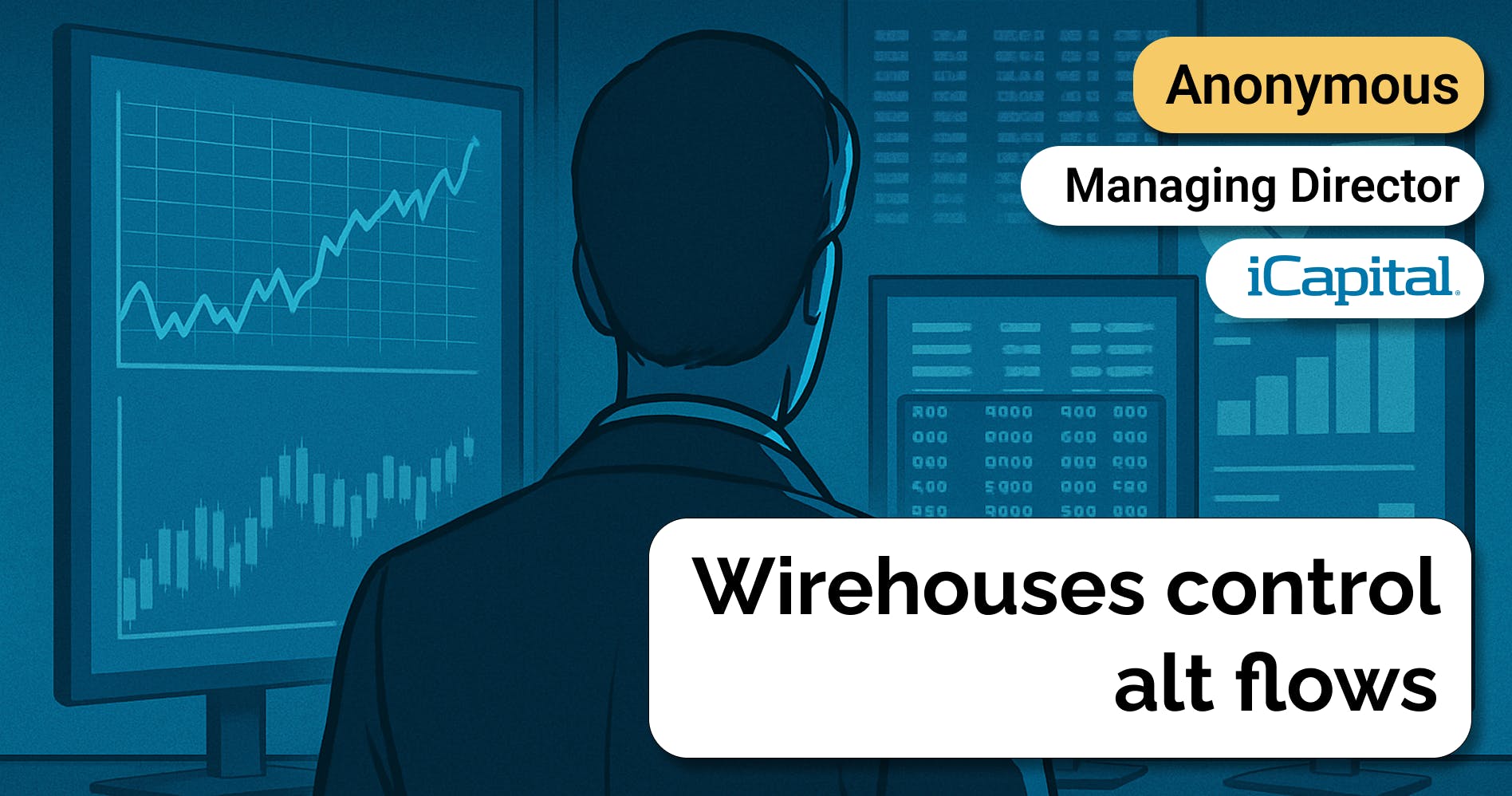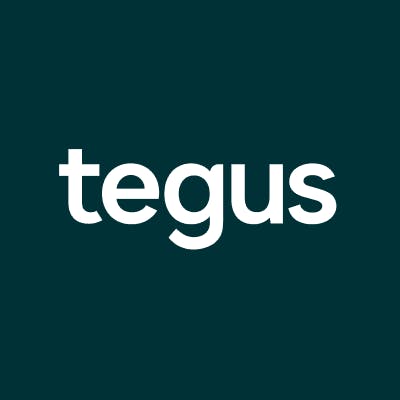Managing Director at iCapital on the AML/KYC chokepoint in private markets
 Jan-Erik Asplund
Jan-Erik Asplund

Questions
- My understanding is that iCapital actually has quite a few customer types that are important. How would you break that down? Who's buying and how do the needs overlap or diverge between the main customer segments?
- Right. Makes sense. One, two follow-up questions on that. So big bank wealth managers, would they fit into the asset manager bucket? I assume no.
- So in the case of big bank wealth management arms, they would be just a sort of equivalent to like a super large RIA client almost.
- Okay. And then, the term wirehouses is actually new to me. Who are we talking about when we're talking about wirehouses?
- I see. And why is—is it just size that's a differentiation, or is it some specific sort of position in the market in terms of distribution?
- So is this essentially a marketplace. You have the demand side, which is the wealth advisers, whether they're big, like the wirehouses, or small, like the RIAs who are kind of a long tail. That's the demand side. And then the supply side are the GPs, the asset managers, the funds that develop the products that the demand side is ultimately connecting with. And then you have an Envestnet that's kind of like a channel partner for iCapital. What does that two-sided marketplace view get wrong about how all this works?
- You mentioned a couple of times the data, and then separately, the research aspect, becoming increasingly important. Can you speak to that in more depth?
- The feeder funds are monetized through, I assume, some combination of management and transaction fees. These are a big chunk of the business. But isn’t the software, the fund subscription workflows, along with the research and data side of the business already significant?
- So two follow-up questions on that. One is, to what extent is having these feeder fund relationships for these traditional funds—to what extent is that a helpful wedge in making that leap to the data and software business?
- In terms of revenue breakdown, you mentioned it's not even close. But I mean, I don't know to what extent this information is public. Is there a rough revenue/growth breakdown that you could provide?
- Okay. And in terms of this backdrop that basically investors want to go direct and they want to access these registered funds versus the feeder funds. And part of that is because there’s more liquidity and you can come in and out easier?
- So this whole data, research, and software business model is more applicable to that—to that style of investment and that shift in capital?
- I'm curious about direct competitors, but I'm also curious about partnerships—you mentioned Envestnet as kind of like a partnership thing. What are the main technology names or comparable companies that are most relevant to iCapital, whether it's as a competitor or like an ecosystem partner or integration point?
- I see. And what would you say is the biggest technology opportunity specifically for iCapital? You mentioned blockchain, some kind of ledger. Of course, everyone today is talking about AI. How do you view the technology opportunity moving forward?
- What about just market data? I mean, it feels like this space is really fragmented. Just speaking about private equity, private credit, hedge funds, private real estate. Is there not an opportunity in terms of an AlphaSense or a Bloomberg type window into these markets?
- Is that the key barrier? The lack of apples-apples comparisons to be made between these products?
- VC is a subset of private equity. But why does it not seem to be any or a significant part of the mix here?
- But with iCapital specifically, if you think about iCapital's total volume—
- So but just to boil it down and simplify it for me, these core customers that iCapital is working on—I mean, at a fundamental level, they're just not doing a lot of volume in VC. So it's not really that relevant to iCapital at this point.
- It’s interesting because then the underlying data tends to show whatever is happening in private wealth, and that is whatever is happening in significant volume. And what drives revenue for iCapital is the high volume areas.
- What are the strategic or product forks in the road for iCapital moving forward, maybe three to five years out? Maybe a way to frame it is in terms of build, buy, partner decisions?
- Is the family office space relevant in this context or not really?
- And when you look at companies like Addepar, some of the companies that are comparable to Addepar, my understanding is that Addepar was recently making a big push into the RIA space, after starting with a lot of family offices and institutional wealth managers. What is the adjacency or overlap with a company like Addepar?
- What's the price range that we should be thinking about in terms of an annual cost for being a typical user of iCapital?
- It seems like there's a little bit of a fundamental tension with iCapital. As you mentioned, the revenue is much more meaningful in terms of the feeder fund business, the conduit fund business. The fees are larger, as we just mentioned, on a basis point basis as well. And that's where the volume is. On the other hand, there seems to be more growth and dynamism in other parts of the business that aren't based on this model. Isn’t it difficult to ride another trend when the core part of your business is based on a totally different model?
- In terms of the bottom up market forces, is there any other trend besides this migration to these new kinds of funds where more people have access, this broadening of the base via registered funds? Is there any other structural bottom up trend that we should be keeping our eye on in terms of investor demand in alts?
Interview
My understanding is that iCapital actually has quite a few customer types that are important. How would you break that down? Who's buying and how do the needs overlap or diverge between the main customer segments?
Sure. And there's a lot of—it's evolved over the years, and I've been there sort of towards the beginning and building it out.
But there are a few different segments. So one segment is what you'd call—which is where a lot of the revenue had come from initially—is what you call the wirehouses. So it's four wirehouses now I think. And I guess you could also add the top of the warehouses in that segment, like the IBDs and then the large RIA aggregators, which are becoming almost like mini wirehouses. So those are one customer segment. In that case, when you talk about investing in alternative investments, it'll be private equity, private credit, hedge funds, etc.
What iCapital and others had done is set up a lot of conduit funds and acquire the book of these conduit funds, which had been built at these banks and other institutions, even like a Raymond James, etc., over the years and manage those books of business, acquire those books of business. So it's a big constituent.
The sales model and entering these funds is more captive, because you're selling into the channel if you're an asset manager, and everyone's sort of in the same pot and they're investing the same way from an operational perspective, each investor, and it's not—you're not going to be disparate.
So that's one segment would be—at the top level where I'd say the wirehouses still, particularly in some of the registered products, are a significant percentage of the alts that are sold. If you were to look at private wealth and look at—you probably have more than 50% of the flows as last I saw in that channel in the wires versus the entire—all the RIAs and etc. put together.
So then the next channel would be the RIAs. Independent broker dealers. They're buying for their client constituency. They're investing. What's different with that channel is you may see a lot more reliance on research. So what iCapital and other firms have been able to do, mostly iCapital, is provide research and a stamp of approval on certain products that are offered in that channel. And that is what the RIAs are—and the RIAs sort of access iCapital a little bit differently.
And then it's more blocking and tackling day to day. When you're selling into that channel, it's a different type of process. You're not really working to get a platform, to paint it in a platform. You're going day to day, hand to hand, office to office, and trying to sell into that. And in some cases, iCapital and others would act as a placement agent, in addition to the typical other client base.
And then the other client base, the main client base that they also work with is the asset manager. They've signed up a lot of asset managers. The asset managers is really leveraging this provider to post their information online, get access, create workflows, leveraging iCapital.
We'll see iCapital versus other competitors to build conduit vehicles, build feeder funds, build other structures both in the US as well as outside the US to facilitate capital so they don't have to take multiple subscriptions from other investors.
We're also leveraging technology from a flow where they would take investors on a direct basis, and it becomes more of a workflow. All this stuff—you're moving these conduit vehicles will exist, but you're moving with proliferation of registered funds. This all probably ties into the questions you may have. It's all converging and moving towards that company and others becoming more of a data company versus becoming more of an asset manager or even a workflow because workflow is still important.
It's still clunky to buy these products. But in reality, some of the things like electronic subscriptions are sort of commoditized at this point. Everyone has those. And then you're looking at what's the differentiation and that becomes data, and we can even talk a little bit about that in a few minutes or so. But those are the main client segments.
You'd say you have the wires, you have the GPs, which you call the asset managers, you have the RIAs, and then you have just other partnerships, which would be providers like connections with Envestnet or connections with others where they're basically just using that as a conduit to funnel people towards products that are listed. But I wouldn't call them—they're kind of unique. They're sort of a constituent. I don't know if they're really a client base, but that's what I see as the core client base there.
Right. Makes sense. One, two follow-up questions on that. So big bank wealth managers, would they fit into the asset manager bucket? I assume no.
It depends on what they're doing. I mean, there are situations where you have clients like Morgan Stanley as an example, where you have an asset manager inside of the bank. Wells Fargo used to be the same, but Wells Fargo sold their business off. So no. They're not really asset managers. They're wealth managers. They're really distributors, if you will. And then you have the asset managers who have distribution arms, but they're not pure distributors. They're manufacturing products as well.
So in the case of big bank wealth management arms, they would be just a sort of equivalent to like a super large RIA client almost.
Yeah. I mean, the banks are exactly. So they're—but they're very large. I mean, the Morgan Stanley's alternative platform is probably about $200 billion at this point. And the RIAs are catching up. The aggregators like I said, the aggregators will become like mini wirehouses. But the production—because I don't know if this is discussed in the other areas. In our areas, it's all of a flat fee. It's all flat recommendation. It's not as—there's no real differentiation in what a product pays versus another product.
So it becomes—that's part of the challenge. And there's still a lot of differentiation from a compensation perspective of large advisers in doing these alternative investment products versus other products. Even though it makes sense for high net worth, a lot of that business is placement. So you have a huge concentration of the alts being sold in private wealth still to placement based, traditional, highly compensated product type situations with large advisers and these wealth managers.
Okay. And then, the term wirehouses is actually new to me. Who are we talking about when we're talking about wirehouses?
Oh, it's an old school term. There's four wirehouses. So Morgan Stanley, Merrill Lynch, and that was part of Bank of America, UBS, and Wells Fargo are the four wirehouses. So they're the larger players, and there's some other players that are sort of smaller, but they're not—like Raymond James or something like that that are smaller, but they're not RIAs. But for the most part, they're—but they're not the wirehouses, which are the big players.
I see. And why is—is it just size that's a differentiation, or is it some specific sort of position in the market in terms of distribution?
It's size, it just comes from a term of how they used to be transmitted back in the day with the desks and the wires to the trade operations room, etc. But there's only four wirehouses left. It's sort of an industry thing, but they are the biggest distributors.
So they remain the biggest.
So is this essentially a marketplace. You have the demand side, which is the wealth advisers, whether they're big, like the wirehouses, or small, like the RIAs who are kind of a long tail. That's the demand side. And then the supply side are the GPs, the asset managers, the funds that develop the products that the demand side is ultimately connecting with. And then you have an Envestnet that's kind of like a channel partner for iCapital. What does that two-sided marketplace view get wrong about how all this works?
Well, the reality is, first of all, these products are—marketplace is part of it, and it's sort of the early innings with these Envestnet partnerships. The bulk of these products are really sold with partnerships between certain asset managers that have large sales forces and high net worth advisers that have done it before.
So the idea is to broaden it and create a marketplace like this marketplace. But the marketplace—sort of the reality, you're not going to—it's a way to present it, and then also—what I'm trying to say is you don't really shop for these things. So you don't—it's not as if you're going to see the marketplace and say, "Oh, look at this product." You can, but it's not really the driver of the growth.
So what I'm saying is if you were starting a new firm and you wanted to try to do a marketplace without any sort of asset management part of it, any conduit feeders or anything else, standing up tech, blockchain, or whatever, you would have a lot of significant challenges earning a profit by just doing something like that. You would need more of a diversity of a business, even though there's significant growth in this. And where that comes in is tech solutions, data and then building an ecosystem that enables you to charge by transaction down the road. And that requires scale.
And only a few asset managers really get to scale with their products that require conduits. So what I'm trying to say is that the marketplace is a big component of it. It's certainly growing. But the dollars either come from—a lot of these—in the US, I mean, there's offshore. There's some growth there, and there's a lot more variability of types of structures and ways that people can gain entrance to products, which creates a lot of—you have interesting ways.
And that becomes where you have the registered fund versus the traditional 3(c)(7) as they call, which is the higher qualified purchase product versus the accredited investor product. And so these are all factors. What I'm saying is that I don't know who you're talking to, but if you were to set something up just trying to be another marketplace or a subscription provider or something like that, it certainly creates a challenge because of the need to sell the product versus see it and buy it.
You mentioned a couple of times the data, and then separately, the research aspect, becoming increasingly important. Can you speak to that in more depth?
What some of the firms want to do is—the RIA aggregators or the RIAs, etc., don't have the resources to diligence these products effectively. And that requires IDD and operational due diligence as well. So what iCapital's done quite a lot and others is they'll diligence a product, and then they'll market it as approved on their side as cleared. And that enables some of these RIA aggregators and other providers or even like a—I don't know. What are the mid level firms or something? I said, Terrace or someone—say, "Okay. Well, this has been vetted, and then we're going to offer this on our little," what they call white label, which is the listing of certain products for an individual firm or individual asset manager or the marketplace. "Say this is out of the marketplace. It's been cleared, and we're comfortable with you buying it."
So that's one thing that's being done from the research perspective, and they're just doing more and more funds. It's a help to the asset manager as well because the asset manager has their product cleared. Then we've vetted and then it makes it easier for potentially people to buy it.
And then on the data side, what they're trying to do is build a ledger and build all sorts of other forms of connectivity. So information that when a transaction takes place, either with iCapital platform or elsewhere, it gets sent directly to the receiving party, whether that be administrator or another provider or the asset manager themselves. And then, potentially, down the road, it becomes part of just a blockchain solution so everyone's looking at the same thing.
And that's sort of where things are headed so their revenue streams become more diversified, not focused on a management fee solely that they'd earn on a feeder or a conduit fund, but more on the data and the technical connectivity between parties.
The feeder funds are monetized through, I assume, some combination of management and transaction fees. These are a big chunk of the business. But isn’t the software, the fund subscription workflows, along with the research and data side of the business already significant?
It's growing, but it's not—it's not close if you were to look at the revenue streams. There's still—they have the structure in place there, and there's others, but from tech-only compensation perspective versus the asset management fees on the administrative side, it's not even close.
So the future state is that in the future iCapital will acquire companies and put people together that have more reporting and data and contacts and partnerships. But at the end of the day, that's what I'm saying—this is the reason I say it'd be difficult for someone to jump in here is that you need that asset management base. Whatever kind of company you have, you need that recurring revenue base. And that can be accomplished through data, but right now, it's certainly still in the early stages if you look at the revenue streams.
So two follow-up questions on that. One is, to what extent is having these feeder fund relationships for these traditional funds—to what extent is that a helpful wedge in making that leap to the data and software business?
I think it's helpful somewhat. I mean, ideally, the problem with the conduit funds is the conduit funds—people would rather go direct now and not go through the conduit funds. So this conduit fund business it's really based on pushback from the asset manager, for the most part. Certainly, if they do well, I mean, from an iCapital perspective, having the assets captive in these conduit funds enables the structuring and connectivity of data, etc.
But the issue is that the conduit—there's reporting, but there's no real interaction with the asset manager or even the fund administrators—if someone's invested in the conduit fund, they're not really interacting with the asset manager directly at all. So it's—there's a separation there. I don't really know how that really factors in. It certainly helps, but I think the conduits are sort of—need to evolve to the next generation, and they are what they are. They're always going to be around, but I think it's certainly not the ideal investment structure for most people.
In terms of revenue breakdown, you mentioned it's not even close. But I mean, I don't know to what extent this information is public. Is there a rough revenue/growth breakdown that you could provide?
No. And they're—I haven't seen their financials in a while, and they're not public, so I can't really—so I could say that the conduits are providing a lot more revenue because they're concentrating these big books of feeder funds. But they've—they've managed to roll out new products through an acquisition and elsewhere. There's certainly a lot of new products and they have a huge pipeline. But I can't really talk about the breakdown, and it's not public. But I'd say that they have a much bigger revenue base than competitors. That's for sure.
Okay. And in terms of this backdrop that basically investors want to go direct and they want to access these registered funds versus the feeder funds. And part of that is because there’s more liquidity and you can come in and out easier?
Yeah. I mean, a lot of the capital is moving towards these products. I mean, direct is different. There's direct and then there's these registered funds. I mean, the qualification of the registered funds enables them to be eligible, accessible for probably six to eight times as many households or more than are eligible in the US to invest in the QP funds, which are the ones that require the conduit.
So, yeah, it's a big trend. I mean, I don't think the performance has been tested yet. But the—it's a huge proliferation on these total return funds. You have more of the BDCs as well. And then you have—they're even starting to come up—create registered versions of secondary funds. So it looks like Templeton's done that. So, yeah, that's where everything's headed, and that was sort of a seismic shift the last couple of years from X to Y, and it just opens up the universe to a lot more investors.
And those investors need—the model, the service is different—you're creating more of a tech only relationship with those clients and creating ways to better facilitate them. Then you have subaccounting, and you have TAs versus your typical administrator providers, and it creates all sorts of downstream implications.
So this whole data, research, and software business model is more applicable to that—to that style of investment and that shift in capital?
Yeah. Yeah. I think the research is separate—because it's not kind of product agnostic, but, absolutely. I think this change—this change in the mass in the higher volumes potentially over time when they catch up. But it—again, you still have a higher percentage of these transactions in these products that are actually sold at the wires a lot more. So we have a huge chunk of the registered funds are still in those four firms.
So it'll catch up and spread, but it's definitely a seismic shift the last couple of years where you have a proliferation of the price. Now, again, you need to see how some of these perform. Some are doing very well so far, but there's ways to—they need to be tested a little bit better, and they haven't had liquidity crunches yet to see how they perform from a liquidity perspective.
But still, you—they'll be—I expect there's going to be a return to the primary—not displacing these, but they'll be sort of—it'll come back. I think you'll see more wealth into private markets and different—but just might be a couple of different slices with defined contribution and stuff like that that'll come up.
I'm curious about direct competitors, but I'm also curious about partnerships—you mentioned Envestnet as kind of like a partnership thing. What are the main technology names or comparable companies that are most relevant to iCapital, whether it's as a competitor or like an ecosystem partner or integration point?
Yeah. There's a lot of partners. The administrators, first and foremost, are certain to become somewhat competitors. So you have an SEI, Treble marketplace, Bank of New York to some degree. So these are pretty clunky firms. SS&C, if they could ever get their act together, could be a competitor.
CAIS is a direct competitor for a while. CAIS is starting to pick up. They've done better on the marketing side. Again, they don't have really lots of conduits. They don't have any of the wirehouses. They don't have any of the other clients that provide significant revenue. But they're attacking in the independent space with the RIAs, etc. And I'd be surprised if CAIS is profitable, to be honest with you. I don't know, but I don't think they would be, despite their growth.
And also, you have firms like Subscribe, and then you have Moonfare. Moonfare is out in Europe, who has a firm that you're going direct to direct to LPs in a model that avoids conduit funds.
I see. And what would you say is the biggest technology opportunity specifically for iCapital? You mentioned blockchain, some kind of ledger. Of course, everyone today is talking about AI. How do you view the technology opportunity moving forward?
Well, AI could help a lot with the subscription workflows a little bit from—but there's issues with error. I think the real opportunity is in whatever it be a DLT solution, ledger solution, or an improved workflow. But something they've been trying to do is just the connectivity of all the parties in a seamless way.
So you have—it made improvements in the front end so people know where their subscription is. They know they're getting in the funds years ago. You didn't even know. He sent away the paperwork. He didn't know what happened. So all that stuff's transparent. I think that and the connectivity to other ways. And then improve in more timely reporting all mixed together with it from a data perspective as well. Because there's still a lag in reporting. There's a lag when there's a kind of a vehicle even further. And to get better than that, and then yeah.
The other thing that's been trending, which everyone's they're pushing. I'm not sure what that's going to do is models. Model portfolios and model portfolios and allocating there. But from a tech data perspective, putting everything on the same page, though, and where there are gaps, the gaps are—or where that information goes to the next party, goes to the administrator TA or the asset manager. There still isn't ways where that information comes back and forth cleanly.
The ledger could potentially help with that. But having the right fees and data connectivities and APIs in a scalable way is where the technology opportunity is. That on top of having much better reporting and porting inside portfolios, which you're starting to get to, and in ways you can see consolidated views of not just two products that you bought there, but the entire—your entire portfolio.
What about just market data? I mean, it feels like this space is really fragmented. Just speaking about private equity, private credit, hedge funds, private real estate. Is there not an opportunity in terms of an AlphaSense or a Bloomberg type window into these markets?
I don't know about that. There are some companies that provide look throughs in the portfolios, and you could set it up that they've been around a number of years or so. I think there might be some opportunities. The question on hedge fund, I mean, you could have hundreds and hundreds of investments, and you have derivatives and stuff like that. That's sort of hard to track there, but the problem is that the challenge in valuing these portfolio companies and biofirms makes it hard to—you probably would be beneficial if you could show more without paying few subscriptions, more data and comparable products and comparable firms versus trying to track what's in the underlying investments.
And then when you have more proliferation of offshore stuff and things in Japan, other countries, there's an opportunity to try to work on create mechanisms to value things a lot faster. But as far as a market data service, it's interesting. I don't know what you could do there given the reality of how these things transact. But I do think that there's an opportunity. Anything that could value things a lot faster. So within a portfolio, there are a lot of opportunities, but sort of like general market data, it's like these things are not liquid. These things are not transparent. You can't have some dashboard of all these funds and how they're performing relative to each other. That's not really realistic. There's not a lot of apples to apples comparisons you can make.
Is that the key barrier? The lack of apples-apples comparisons to be made between these products?
I mean you could do it. You could do something like that. I'm just saying is that it is what it is. So that—you could have funds and you could put it in there and you could look at—you could do the—everyone's wanted to do the full look. They've asked for this for years. The banks, etc. Then you do a full look through of whether the investment's even in the fund and then put that all into the system. And there's some firms that have something like that and parametrics and stuff like that. Other firms sort of done it, but when you have really highly illiquid fund products and stuff, it's hard.
And if you have loans in a portfolio, if it's a loan based fund and—it just becomes—and especially when you have leverage loan stuff, it's harder. I think if you could do it, it would be valuable. But I think it's just a matter of seeing what someone's really going to produce.
I mean, what iCapital has is from a company called Mirador that they bought, and those guys are sort of integrated into tech, but they were pretty much a firm that would work with third party providers and then put bodies on top of it to make sure that the data looked okay. And that's not really ideal or scalable in the long term. And there was a value—it was valuable for those family offices. And then in this business, you also have very concentrated positions. You have X number of clients that own the preponderance of the investments, to some degree. But yeah. I think there's some opportunities. It's just—just you have to be realistic, and you can't go out there promising X, Y, and Z when you have those hard to value assets, it would have to be something else. And intraday in a hedge fund would be tough as well.
VC is a subset of private equity. But why does it not seem to be any or a significant part of the mix here?
I mean, it's the same as all these funds, the VC funds or buyout funds or whatever. You have good vintages and bad vintages. I think you're at a point now probably from an investment perspective where you got some crappy funds and it's maybe going to come back eventually. And you also, you're at a point where you have this disparity between the public markets and private markets. Everyone's like, the public markets are only a small slice. If you look at the private markets, it's much larger. But the reality is that you can't assume that performance of public markets doesn’t hit the private markets. So I think VC will come back as cyclical. I think you had—you had different bad vintages. I remember 2000 was a bad vintage, and then 2004 was bad vintage, 2006, and then you had some good ones towards 2012, 2013, 2014. So it's like anything else, cyclical.
Some large funds, if Tiger is an example, and others that raised a lot of money in VC funds, had some significant issues with some of their investments as well.
I mean, iCapital represents the industry. So they're not—they're not picking X, Y, and Z that they choose to sponsor, but VC—that's a very small segment of the business they do. So the business that they're doing is the business that's being done in private wealth. So if they don't have VC funds and then asset managers aren't doing VC funds and using them or just going out to invest, then there’s no real volume in private wealth or asset raises right now in private wealth or anywhere else.
So but just to boil it down and simplify it for me, these core customers that iCapital is working on—I mean, at a fundamental level, they're just not doing a lot of volume in VC. So it's not really that relevant to iCapital at this point.
That's right. It's not relevant. The type of product is irrelevant to them because they take all comers. They're not—it's just—they're pretty representative of what's happening at this point given their flows. But, yeah, it has nothing to do with them on a particular asset type at this point.
It’s interesting because then the underlying data tends to show whatever is happening in private wealth, and that is whatever is happening in significant volume. And what drives revenue for iCapital is the high volume areas.
Yes, one thing about iCapital is they can provide more data to the private wealth industry, which they haven't really done. They have a huge amount of the flows running through their platform for the private wealth industry, and they are representative of what's happening. So they're not going to—they're not going to weed out X fund or Y fund. They’re going to have everything. I mean, they're also doing a lot more business in Asia, Japan, Australia, Europe, and The Middle East. Europe's always been a struggle, and then Latin America for them is becoming significant as well.
So it just really depends on what's being marketed and available in private wealth. But VC funds have had a rough couple of years.
What are the strategic or product forks in the road for iCapital moving forward, maybe three to five years out? Maybe a way to frame it is in terms of build, buy, partner decisions?
Well, I think there's opportunities to improve the AML KYC space on investors. I think they're going to make investments, do more investment in blockchain beyond what they have built internally. I think they'll probably buy a company ora few companies—because they just raised a lot of money as you saw. I think the opportunities they're going to look at are maybe partnering with administrators or some administrators.
And I think AI. There'll be some AI investment or something, and then maybe additional products. I mean, they've expanded to annuities. Annuities are old school, but annuities are about $350 billion a year that are sold. And they have the structured notes business, structured products business. I think just more stuff partnering with the financial advisor base, and then maybe they expand their institutional services, although institutional has been sort of flat.
But what I'd see for them and what the opportunities are really on improving the ledger, the data and the sale of data. So not just data, but how you can monetize information that you have to some degree. The caveat being that most of that data belongs to somebody else, like the wealth firms, etc. But ways that they can monetize and sell data, ways that they can improve the connectivity between parties, would make them a lot more money, because they can charge for a much larger number of transactions.
And then I expect them and others to probably invest and partner more on the AI space and a little bit more improve the blockchain. And then again the AML KYC of investors is still a challenging space as well.
Is the family office space relevant in this context or not really?
It is. I think iCapital is looking to expand more into family office services. Those are challenging kind of niche things, but I think family office will become more of a part of what they do as well.
And when you look at companies like Addepar, some of the companies that are comparable to Addepar, my understanding is that Addepar was recently making a big push into the RIA space, after starting with a lot of family offices and institutional wealth managers. What is the adjacency or overlap with a company like Addepar?
I think they're—they partner with iCapital. I don't think there's a lot of overlap. I think iCapital's outgrown them. I think they're bigger. But Addepar—I think just some of how the data solutions look is similar to Addepar once we put it together. But there's not a lot of overlap. I think it's complementary, and I think you would leverage Addepar as a partner if you're iCapital to get information out there and get various reports to folks.
And then because even that firm that iCapital bought, Mirador, it sort of just rides along on top of the other tech providers in Black Diamond and others like that. It's not in and of itself building the engine to produce that information. I don't see so much of an overlap. I think that's just another partner, another player in the space that's expanding and they have to charge a lot, which has been a challenge for them. But iCapital is just another way for Addepar to get information as they expand beyond originally, the family offices and big advisers.
What's the price range that we should be thinking about in terms of an annual cost for being a typical user of iCapital?
Well, if you get services and you get your fund managed and stuff and that costs you all in 15 to 25 basis points, I think that's fair. Typically, the asset managers should be picking up most of that cost for access. So, yeah, the price point is really—it's a little bit higher now. And if you're just getting data and fund managed services, probably 15 basis points. If it becomes research and then some placement, etc., then you can get up to 30, 40.
I think they were at 50 for years, 40 to 50 on funds that they roll out as a placement agent and run the funds. And then most of the wirehouses are at 20 basis points, 20 basis points for most of their funds, and then they get down to 15 at the mega-size level. And then GPs are paying about 15 basis points to get tech solutions, if you will, and get their stuff out onto the marketplace.
It seems like there's a little bit of a fundamental tension with iCapital. As you mentioned, the revenue is much more meaningful in terms of the feeder fund business, the conduit fund business. The fees are larger, as we just mentioned, on a basis point basis as well. And that's where the volume is. On the other hand, there seems to be more growth and dynamism in other parts of the business that aren't based on this model. Isn’t it difficult to ride another trend when the core part of your business is based on a totally different model?
I think you're right in identifying it. It's definitely challenging for a little bit, but I think they'll be able to navigate it—like other industries if you look over time, have been able to do and change business models. I think they'll navigate it. If they're able to get the tech in place properly, they'll navigate it to a decent sort of tech subscription model where that becomes in that 10 or 15 basis point range but they are doing it on very high volume. And then they provide complimentary services as well.
And then if they balance that with their structured notes business, which is a little bit different and they act as a placement agent, they'll be fine. It's just that the feeders are certainly a big chunk—biggest chunk of revenue, but they're still growing at a very good rate. So I think that they’ll pull it off, and they're probably in the best position to do so.
Now if the tech—if their tech doesn't get better and their operations don’t get better, it's another story because they have some challenges there. But from what I hear often—I think that, it'll take time, but they'll have to evolve into that model, and that becomes the model going forward. Sort of akin to where the phone companies have gone, where cable's going, where you evolve from one model, you're still relying on monthly fees for services, and then you move into more of a software model. And I think that's where things are heading where they want it to go, longer term.
In terms of the bottom up market forces, is there any other trend besides this migration to these new kinds of funds where more people have access, this broadening of the base via registered funds? Is there any other structural bottom up trend that we should be keeping our eye on in terms of investor demand in alts?
There's one trend that you should look at—if it can materialize that would be great—is secondaries and the need for liquidity. So more attempts at liquidity. I think that's something that people are just trying to solve and creating mechanisms where people can shorten the duration of their long term products. I think that's sort of a trend that people are looking at, and there’s been more proliferation of secondaries, not just as funds, but as opportunities for people in private wealth.
So I think it would be registered funds, like you said, but I think the secondaries are something to keep an eye out for because there's significant opportunity there.
Disclaimers
This transcript is for information purposes only and does not constitute advice of any type or trade recommendation and should not form the basis of any investment decision. Sacra accepts no liability for the transcript or for any errors, omissions or inaccuracies in respect of it. The views of the experts expressed in the transcript are those of the experts and they are not endorsed by, nor do they represent the opinion of Sacra. Sacra reserves all copyright, intellectual property rights in the transcript. Any modification, copying, displaying, distributing, transmitting, publishing, licensing, creating derivative works from, or selling any transcript is strictly prohibited.













